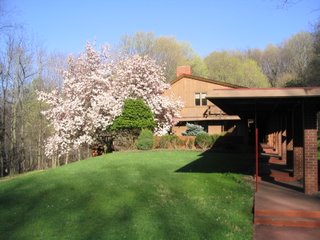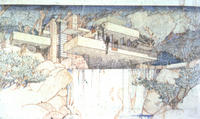Frank Lloyd Wright

Frank Lloyd Wright was born on this day in 1867 in Richland Center, Wisconsin.
Wright's earliest influences were his doting mother, who had decided he would be a great builder before he was born, and the writings of Ralph Waldo Emerson, who sought to define for America a wholly American aesthetic and a wholly American way of life; it would be Emerson's exhortations which would subconsciously play through most of what Wright tried to achieve in his work during his enormously productive 92-year life.
He found his passion for architecture early, preparing for it by studying engineering at the University of Wisconsin. After working as a draughtsman and later as chief assistant to Louis Sullivan, he opened his own firm and was immediately successful. His first commission, a dramatic house for W. H. Winslow, launched a period of critical acclaim, and among his earliest champions was Charles R. Ashbee, the well-known Arts-and-Crafts designer.
During this early period he sought in each design to develop a style which was distinctively Midwestern, and soon became the leading interpreter of the architectural movement known as the "Prairie School." For Wright -- stimulated by the writings of Ruskin, the aforementioned Arts-and-Crafts movement and Japanese architecture -- this style developed into "organic architecture," in which buildings were integrated into and inspired by the landscape rather than imposed on it. His credo: "No house should ever be on any hill or on anything. It should be of the hill, belonging to it, so hill and house could live together and each the happier for it." His interiors replaced the traditional compartmentalization of a home with one in which large, open living spaces predominated and interior rooms flowed into external balconies and terraces, and into which nature was invited through the use of expansive windows.
While most of his commissions were for private residences (such as the Kaufmann House, known as "Fallingwater," in Connellsville, Pennsylvania, 1935-48, his masterpiece), he also designed many public buildings, including schools, churches (notably the Unity Temple in Chicago, 1905-08), corporate headquarters (such as the Johnson Wax Building, 1936-39), and hotels (including the Imperial Hotel in Tokyo, 1913-22, which survived the 1923 Great Kanto earthquake only to be torn down during civic modernization in 1967), as well as the astonishing geometric exercise that became the Guggenheim Museum (New York City, completed 1960).
In all, Wright designed about 800 buildings, 380 of which were built. His designs were known for their originality, spaciousness even in small structures, and, unfortunately, for their chronically leaky roofs -- but, as one client quipped, "this is what happens when you leave a work of art out in the rain."
Wright's personal life was scandal-ridden, a fact that decreased his popularity for a time: he and his first wife separated soon after their sixth child was born, and Wright lived for a time with a mistress until she was brutally murdered with her children in his home by a deranged servant; he married a second time to a morphine-addicted sculptor before running away at age 58 with 26-year old Olgivanna Hinzenburg, with whom he had a child before taking her as his 3rd and last wife in 1928. His primary home in the Wisconsin countryside, Taliesin, burned during the murder episode, was rebuilt twice and temporarily seized by the bank when Wright's finances were at a low ebb.
When it looked as though his career was over in his 60s, Wright outflanked the International Modernists such as Mies van der Rohe and Le Corbusier with his own new revolutionary style, and began to extend his evangelical efforts when he built Taliesin West (1937, Scottsdale, Arizona) as a studio and retreat for his student disciples. He had a colossal ego and did not collaborate willingly; for the sake of his architectural vision, clients sometimes found that his designs did not always accommodate their personal objects, or they might bump their heads on his stubbornly low doorways. In fact, Wright had a talent for making even the most progressive thinkers appear to be philistines: when modern abstract artists Willem deKooning, Franz Kline and Robert Motherwell publicly denounced his design for the Guggenheim Museum, he ended up making them look like reactionaries after enlisting the aid of Robert Moses (of all people, a man who preferred to build expressways than anything remotely like human-scaled shelter) to make sure the Guggenheim would be completed.
Up until his death on April 9, 1959 in Phoenix, Arizona, Wright collected promising young architects around him in his Taliesin Fellowship -- incidentally leaving them, according to disciple Edgar Tafel, with a shared lack of a solid grounding engineering principles, but exhorting them nonetheless to explore new technologies, to maintain consistency in device, and to use a minimum of "design" to achieve maximum aesthetic effect.
Labels: Architecture, Frank Lloyd Wright














